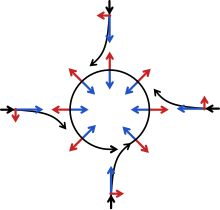Geostrophic wind

The geostrophic wind ( Greek γῆ 'earth', στροφή 'turn', 'curve', 'rotation' = roughly "wind that blows with the rotation of the earth") is a simplified physical wind model of meteorology based on geostrophy or geostrophic Adaptation . It is based on wind observations in the northern hemisphere. The specialty is that in the geostrophic wind model, the isobars (lines with the same air pressure) are seen as straight lines . In addition to meteorology, this model is also used in navigation , for example in single heading flights .
Geostrophic wind
The geostrophic wind comes about through an opposing balance of pressure gradient force (drift from high to low pressure area) and Coriolis force . In reality it only occurs at a higher tropospheric altitude, particularly pronounced as a jet stream .
Ageostrophic wind
In the planetary boundary layer of the earth's atmosphere - the peplosphere (lower 1.5 to 2 km) - the wind is slowed down by ground friction . Here it does not blow parallel to the isobars, but rather in the direction of the lower air pressure , whereby the low pressure areas fill up after a few days. The deflection of the wind becomes stronger towards the bottom and, viewed from above, takes on the shape of a spiral , the so-called Ekman spiral (compare Ekman spiral in the area of ocean currents ). If the wind, as described here, is influenced by friction or other influences (so-called ageostrophic components , e.g. vorticity ), one speaks of ageostrophic or geotriptic winds .

